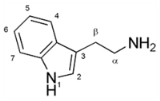
Tryptamine
Overview
Tryptamine is a monoamine alkaloid
found in plant
s, fungi, and animal
s. It is based around the indole
ring structure, and is chemically related to the amino acid
tryptophan
, from which its name is derived. Tryptamine is found in trace
amounts in the brain
s of mammal
s and is believed to play a role as a neuromodulator or neurotransmitter
.
Tryptamine is also the backbone for a group of compounds known collectively as tryptamines.
Alkaloid
Alkaloids are a group of naturally occurring chemical compounds that contain mostly basic nitrogen atoms. This group also includes some related compounds with neutral and even weakly acidic properties. Also some synthetic compounds of similar structure are attributed to alkaloids...
found in plant
Plant
Plants are living organisms belonging to the kingdom Plantae. Precise definitions of the kingdom vary, but as the term is used here, plants include familiar organisms such as trees, flowers, herbs, bushes, grasses, vines, ferns, mosses, and green algae. The group is also called green plants or...
s, fungi, and animal
Animal
Animals are a major group of multicellular, eukaryotic organisms of the kingdom Animalia or Metazoa. Their body plan eventually becomes fixed as they develop, although some undergo a process of metamorphosis later on in their life. Most animals are motile, meaning they can move spontaneously and...
s. It is based around the indole
Indole
Indole is an aromatic heterocyclic organic compound. It has a bicyclic structure, consisting of a six-membered benzene ring fused to a five-membered nitrogen-containing pyrrole ring. Indole is a popular component of fragrances and the precursor to many pharmaceuticals. Compounds that contain an...
ring structure, and is chemically related to the amino acid
Amino acid
Amino acids are molecules containing an amine group, a carboxylic acid group and a side-chain that varies between different amino acids. The key elements of an amino acid are carbon, hydrogen, oxygen, and nitrogen...
tryptophan
Tryptophan
Tryptophan is one of the 20 standard amino acids, as well as an essential amino acid in the human diet. It is encoded in the standard genetic code as the codon UGG...
, from which its name is derived. Tryptamine is found in trace
Trace amine
Trace amines are endogenous compounds structurally related to classical biogenic amines, such as catecholamines, serotonin and histamine. Trace amines include p-tyramine, β-phenylethylamine, tryptamine, octopamine, and 3-iodothyronamine, and are found in the nervous systems of animals from insects...
amounts in the brain
Brain
The brain is the center of the nervous system in all vertebrate and most invertebrate animals—only a few primitive invertebrates such as sponges, jellyfish, sea squirts and starfishes do not have one. It is located in the head, usually close to primary sensory apparatus such as vision, hearing,...
s of mammal
Mammal
Mammals are members of a class of air-breathing vertebrate animals characterised by the possession of endothermy, hair, three middle ear bones, and mammary glands functional in mothers with young...
s and is believed to play a role as a neuromodulator or neurotransmitter
Neurotransmitter
Neurotransmitters are endogenous chemicals that transmit signals from a neuron to a target cell across a synapse. Neurotransmitters are packaged into synaptic vesicles clustered beneath the membrane on the presynaptic side of a synapse, and are released into the synaptic cleft, where they bind to...
.
Tryptamine is also the backbone for a group of compounds known collectively as tryptamines.
Discussions

